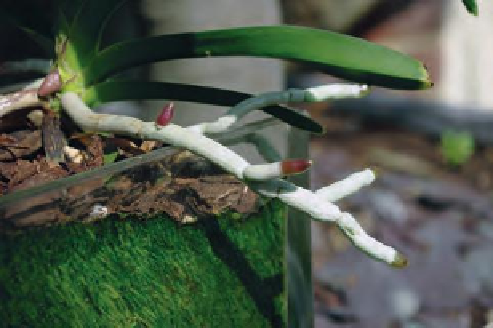Agriculture Reference
In-Depth Information
(a)
(e)
(f)
(b)
(c)
(d)
(g)
Figure 7.14
Some root adaptations: (a) buttress roots; (b) stilt roots of mangrove; (c) prop roots of maize; (d) prop
roots in
Pandanus utilis
; (e) pneumatophores of swamp cypress; (f) velamen roots of orchid; (g) root tuber of a
Dahlia
upright structures for support either clockwise (e.g.
Wisteria sinensis
) or anticlockwise (e.g.
Wisteria
floribunda
)
.
Such twining stems can become large and
woody, which are then called lianes (Figure 7.15a and
b).
Ruscus aculeatus
(butcher's broom) is a native plant
which is adapted to dry, shady woodlands. Its stems
are leaf-like
cladodes
carrying out the functions of the
leaves which are themselves reduced to a protective
spine at the cladode tip. The small buds, flowers
and berries are borne in the centre of the cladode
indicating that it is a stem (Figure 7.15c).
Thorns
, which are modified branches growing from
axillary buds (and hence have a vascular connection
to the stem), can have a protective function (e.g.
in
Crataegus
spp. (hawthorn) and
Pyracantha
)
discouraging herbivores (Figure 7.15d).
Prickles
are
specialized outgrowths of the stem epidermis (so are
easily rubbed off), which not only protect but also
assist the plant in scrambling over other vegetation, as
in many roses (Figure 7.15e).
Many stem adaptations important to horticulture are
also perennating organs storing starch such as some
rhizomes
,
which are stems growing horizontally








